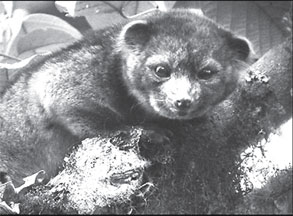A new carnivorous mammal species discovered after 35 years
by Joseph Stromberg
For all of modern history, a small, carnivorous South American mammal
in the raccoon family has evaded the scientific community. Untold
thousands of these red, furry creatures scampered through the trees of
the Andean cloud forests, but they did so at night, hidden by dense fog.
Nearly two dozen preserved samples - mostly skulls or furs - were
mislabelled in museum collections across the United States. There's even
evidence that one individual lived in several American zoos during the
1960s - its keepers were mystified as to why it refused to breed with
its peers.
 |
|
Native to the cloud forests of Ecuador
and Colombia, the
olinguito is the newest member of the raccoon family |
Now, the discovery of the olinguito has solved the mystery. At an
announcement in Washington, D.C., Kristofer Helgen, curator of mammals
at the Smithsonian National Museum of Natural History, presented
anatomical and DNA evidence that establish the olinguito (pronounced
oh-lin-GHEE-toe) as a living species distinct from other known olingos,
carnivorous tree-dwelling mammals native to Central and South America.
His team's work, also published in ZooKeys, represents the first
discovery of a new carnivorous mammal species in the American continents
in more than three decades.
Although new species of insects and amphibians are discovered fairly
regularly, new mammals are rare, and new carnivorous mammals especially
rare. The last new carnivorous mammal, a mongoose-like creature native
to Madagascar, was uncovered in 2010. The most recent such find in the
Western Hemisphere, the Colombian weasel, occurred in 1978. "To find a
new carnivore species is a huge event," said Ricardo Sampaio, a
biologist at the National Institute of Amazonian Research in Brazil, who
studies South American mammals in the wild and was not involved in the
project.
Olinguitos, formally known as Bassaricyon neblina, inhabit the cloud
forests of Ecuador and Colombia in the thousands, and the team's
analysis suggests that they are distributed widely enough to exist as
four separate subspecies. "This is extremely unusual in carnivores,"
Helgen said, in advance of the announcement. "I honestly think that this
could be the last time in history that we will turn up this kind of
situation - both a new carnivore, and one that's widespread enough to
have multiple kinds."
Though Helgen has uncovered dozens of unknown mammal species during
previous expeditions, in this case, he did not set out to find a new
species. Rather, he sought to fully describe the known olingos. But when
he began his study in 2003, examining preserved museum specimens, he
realised how little scientists knew about olingo diversity. "At the
Chicago Field Museum, I pulled out a drawer, and there were these
stunning, reddish-brown long-furred skins," he said.
"They stopped me in my tracks - they weren't like any olingo that had
been seen or described anywhere." The known species of olingo have
short, grey fur. Analysing the teeth and general anatomy of the
associated skulls further hinted that the samples might represent a new
species. Helgen continued his project with a new goal: Meticulously
cataloguing and examining the world's olingo specimens to determine
whether samples from a different species might be hidden among them.
Visits to 18 different museum collections and the examination of
roughly 95 percent of the world's olingo specimens turned up dozens of
samples that could have come from the mystery species. Records indicated
that these specimens - mostly collected in the early 20th century - had
been found at elevations of 5,000 to 9,000 feet above sea level in the
Northern Andes, much higher than other olingos are known to inhabit.
- Smithsonian.com
|


